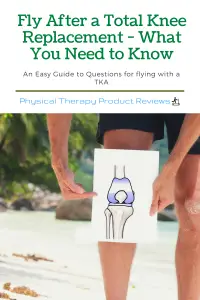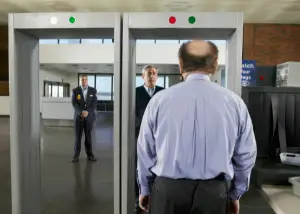Getting a total knee replacement tends to throw a wrench in your plans. But what happens if those plans are set in stone? And more importantly, what happens when those plans require flying?
Some things just can’t be changed, and while it’s more difficult to do so, it is possible to fly after a total knee replacement as long as you consult your physician and follow the recommended timeline.

How quickly you fly after having a total knee replacement depends on how you are feeling and how well you are recovering from your surgery. In most cases, individuals can fly within 10 – 12 weeks post-surgery without needing to consult their physician.
If you are flying before 6-10 weeks after surgery, it’s best to get cleared by your physician first.
To learn more about flying and general traveling tips after having a total knee replacement, keep reading for tips on how to prepare for safe travel.
Time to Fly - Or Is It?
As previously stated, in most situations an individual can fly at the 10 – 12 week mark after having total knee replacement surgery.
Before making any reservations that you cannot back out of, it is a good idea to discuss your plans with your doctor and physical therapist to see what they recommend for your situation.
Everyone heals at a different pace and what may work for one person may not be the same for another.
Planning Your Flight Post Total Knee Replacement
 Planning can save you a lot of time and aggravation when getting to the airport. You may be concerned about whether or not you can make the long trek through the airport terminals after your surgery.
Planning can save you a lot of time and aggravation when getting to the airport. You may be concerned about whether or not you can make the long trek through the airport terminals after your surgery.
- Contact your airline or the airport you’ll depart from to discuss options for mobility assistance when you arrive.
- Most airlines offer wheelchairs or tram rides that you can take to your terminal to reduce the distance that you have to walk and the amount of time you have to wait in long lines.
Avoid the Lines by Getting Pre Approved
In addition to having to walk what seems like miles through the airport, there are also the lines for check-in and airport security that you must contend with.
Check-in and airport security checks can add time to your schedule and discomfort to your trip if you are stuck waiting in a long line for an extended amount of time.
- To avoid waiting in a long check-in line, you can download your boarding pass directly to your smart device ahead of time and quickly check-in upon your arrival at the airport.
- Most airlines offer individuals with medical conditions or implanted devices the option to be pre-approved by the TSA so they do not have to wait in long lines.
That is not to say that you won’t get frisked by the fuzz, but it will speed the process up so that you can get to your flight quickly and with a minimal amount of discomfort.
Will My Total Knee Set Off the Metal Detector?
Many people worry that their implanted device will set off the metal detector while they are going through a security check. Yes, your implant may set off the metal detector, but there is no need to worry.
- Simply let security personnel know when it is your turn that you have medically implanted devices in your body and they will send you through the full-body scanner.
Many times they will also use a metal detection wand to scan the area where the implant is as a precaution. There is no need to get a note from your doctor.

Other Ways to Make Your Flight More Pleasant after a Knee Replacement
If you can afford the extra expense, fly first class. The main reason for this is that there is considerably more legroom so you are not cramped and worrying about disturbing people as you get up to do your stretches and walking during the flight.
If first class is not an option, do your best to get an aisle seat so you can stretch your leg out more comfortably when needed (Just watch out for any passengers or attendants that may be passing through!)
When you finally reach your gate, immediately notify the boarding attendant that you would like to be boarded first due to your total knee replacement, and most of the time they are happy to accommodate your request.
Doctors Discuss Flying After a Total Knee Replacement
Caring for Your Knee During the Flight
Up, up and away! You are finally on the way to your destination. If you have a flight that is going to be over 30 minutes the next section is important.
 This section pertains to what you need to do during a long flight to keep your recovery on the right path and reduce pain and discomfort throughout the flight.
This section pertains to what you need to do during a long flight to keep your recovery on the right path and reduce pain and discomfort throughout the flight.
- Get up and walk every 30 – 45 minutes. It is extremely important to keep moving to promote good circulation and prevent stiffening of your knee.
- Compression socks are also a good way to prevent DVT (deep vein thrombosis) caused by blood clots.
- Do as many of your seated exercises as space will allow: :
- Ankle pumps
- Calf raises
- Seated knee extension
- Seated knee flexion
The last three exercises on the list may not be possible due to the limited amount of space on an airplane but they are very beneficial to your range of motion and circulation, so if you have enough room to do them…do them!
Being seated in one position without moving your knee or getting up to walk puts you at risk for a blood clot. Keep that knee moving!
FAQ About Flying with a Knee Replacement
Should I Use a Cane in the Airport?
You should only use a cane if you really need it. Most people are no longer using a cane or assistive device by the time that they are cleared for flying. It honestly just becomes a hassle and something else that you have to worry about.
You can use the airport buggies and get shuttled through the airport if you notify customer services.
Should I take Extra Pain Medications for Flying after Surgery?
This all depends on how much pain medication you are currently taking. Most people have discontinued taking pain medication by the time that they can fly. There is no need to seek additional pain medication. You can use Tylenol or Advil in most cases.
Should I take Blood Thinners when Flying After a Knee Replacement?
This is something that you can ask your primary care physician. If you have a history of blood clots then it may be something worth considering depending on when you last had surgery.
Can I Sit in an Exit Row After a Knee Replacement?
You can and will enjoy the extra legroom. It is important that you are far enough out from surgery to still be able to help in an emergency. If you don’t think you can be of any help then you should sit in another row.
How Can I Prevent Blood Clots When Flying After a Knee Replacement?
There are 3 important things that you can do to prevent blood clots when flying after a joint replacement.
- Wear thigh-high compression stockings
- Do your Exercises of ankle pumps, calf raises, and knee extensions
- Set a timer on your phone to get up and walk the aisles every 30 minutes
If you do those 3 things that your chances of getting a blood clot are low.
Should I Call the Airline or the Airport If I Have Had a Total Knee Replacement?
You can call both if you want but in reality, you don’t need to call either.
You can all airport customer service to have a buggy or golf cart waiting for you at the entrance if needed but most of the time you can request assistance getting around once you get to the airport.
If you call the airline, you can ask for a seat with more legroom but they may charge to extra for that seat.
Traveling on Land or Sea
Maybe you are someone who would rather take a cruise or a trip across our beautiful country via car, bus or train.
If you fall into this category and have recently had a total knee replacement the same rules apply as if you were flying.
- Stop every 30 – 45 minutes to walk and stretch.
- Do your seated exercises frequently to keep your blood pumping and enjoy yourself as you travel to new and exciting destinations.
Don’t Let Your Surgery Keep You on the Ground
Now that you have all the information you need, it is time to talk with your doctor and physical therapist to see where you are at in your recovery process. If you are good to go, then get to making those plans and get back to doing what you enjoy. Life is too short to avoid experiences because of physical limitations, if you are sticking to your rehabilitation plan and working hard there is no reason for you to be grounded.
Sources:
Other Great Rehab Related Articles
GLP Weight Loss and Back Health: Effective Strategies and Insights
How to Stay Active After Cervical Fractures: Expert Tips and Advice
Dealing with Painful Stairs After Ankle Replacement Surgery
Walking After a Total Ankle Replacement: Tips for a Successful Recovery
Exercises While Non-Weight Bearing After Ankle Replacement: Elevation, AROM, Leg Raises, and More
Ankle Pain with Stairs: Causes and Home Treatment Options
Disclaimer: The information provided in this post is for educational purposes only. This is not a substitute for a medical appointment. Please refer to your physician before starting any exercise program.






